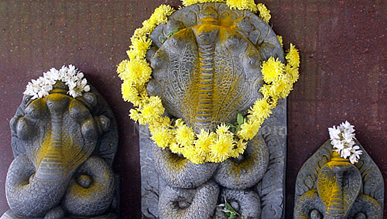NAG PANCHAMI
The Legend
In ancient India, there lived a clan by the name of "NAGAS" whose culture was highly developed. The Indus Valley civilisation of 3000 B.C. gives ample proof of the popularity of snake-worship amongst the Nagas, whose culture was fairly wide-spread in India even before the Aryans came. After the Naga culture got incorporated into Hinduism, the Indo-Aryans themselves accepted many of the snake deities of the Nagas in their pantheon and some of them even enjoyed a pride of place in the Puranic Hinduism.
The prominent Cobra snakes mentioned in the Puranas are Anant, Vasuki, Shesh, Padma, Kanwal, Karkotak, Kalia, Aswatar, Takshak, Sankhpal, Dhritarashtra and Pingal. Some historians state that these were not snakes but Naga Kings of various regions with immerse power.
The thousand-headed Shesh Nag who symbolises Eternity is the couch of Lord Vishnu. It is on this couch that the Lord reclines between the time of the dissolution of one Universe and creation of another. Hindus believe in the immortality of the snake because of its habit of sloughing its skin. As such Eternity in Hinduism is often represented by a serpent eating its own tail.
In Jainism and Buddhism snake is regarded as sacred having divine qualities. It is believed that a Cobra snake saved the life of Buddha and another protected the Jain Muni Parshwanath. To-day as an evidence of this belief, we find a huge serpent carved above the head of the statue of Muni Parshwanath. In medieval India figures of snakes were carved or painted on the walls of many Hindu temples. In the carves at Ajanta images of the rituals of snake worship are found. Kautilya, in his "Arthashastra" has given detailed description of the cobra snakes.
Fascinating, frightening, sleek and virtually death-less, the cobra snake has always held a peculiar charm of its own since the time when man and snake confronted each other. As the cobra unfolded its qualities, extra-ordinary legends grew around it enveloping it in the garble of divinity. Most of these legends are in relation with Lord Vishnu, Shiv and Subramanyam.
It is an age-old religious belief that serpents are loved and blessed by Lord Shiv. May be therefore, he always wears them as ornamentation around his neck. Most of the festivals that fall in the month of Shravan are celebrated in honour of Lord Shiv, whose blessings are sought by devotees, and along with the Lord, snakes are also worshiped. Particularly on the Nag-Panchami day live cobras or their pictures are revered and religious rights are performed to seek their good will. To seek immunity from snake bites, they are bathed with milk, haldi-kumkum is sprinkled on their heads and milk and rice are offered as "naivedya". The Brahmin who is called to do the religious ritual is given "dakshina" in silver or gold coins some times, even a cow is given away as gift.


No comments:
Post a Comment